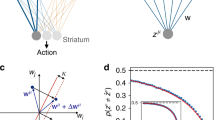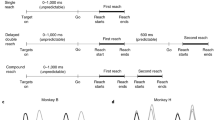Abstract
Psychophysical studies of reaching movements suggest that hand kinematics are learned from errors in extent and direction in an extrinsic coordinate system, whereas dynamics are learned from proprioceptive errors in an intrinsic coordinate system. We examined consolidation and interference to determine if these two forms of learning were independent. Learning and consolidation of two novel transformations, a rotated spatial reference frame and altered intersegmental dynamics, did not interfere with each other and consolidated in parallel. Thus separate kinematic and dynamic models were constructed simultaneously based on errors computed in different coordinate frames, and possibly, in different sensory modalities, using separate working-memory systems. These results suggest that computational approaches to motor learning should include two separate performance errors rather than one.
This is a preview of subscription content, access via your institution
Access options
Subscribe to this journal
Receive 12 print issues and online access
$209.00 per year
only $17.42 per issue
Buy this article
- Purchase on Springer Link
- Instant access to full article PDF
Prices may be subject to local taxes which are calculated during checkout





Similar content being viewed by others
References
Flanders, M., Helms Tillery, S. I. & Soechting, J. F. Early stages in a sensorimotor transformation. Behav. Brain Sci. 15, 309– 362 (1992).
Desmurget, M., Pelisson, D., Rossetti, Y. & Prablanc, C. From eye to hand: planning goal-directed movements. Neurosci. Biobehav. Rev. 22, 761–788 ( 1998).
Gordon, J., Ghilardi, M. F. & Ghez, C. Accuracy of planar reaching movements. I. Independence of direction and extent variability. Exp. Brain Res. 99, 97–111 (1994).
Ghilardi, M. F., Gordon, J. & Ghez, C. Learning a visuomotor transformation in a local area of work space produces directional biases in other areas. J. Neurophysiol. 73, 2535–2539 ( 1995).
Gordon, J., Ghilardi, M. F., Cooper, S. E. & Ghez, C. Accuracy of planar reaching movements. II. Systematic extent errors resulting from inertial anisotropy. Exp. Brain Res. 99, 112–130 (1994).
Vindras, P. & Viviani, P. Frames of reference and control parameters in visuomanual pointing. J. Exp. Psychol. 24, 1–23 (1998).
Morasso, P. Spatial control of arm movements. Exp. Brain Res. 42 , 223–227 (1981).
Pine, Z. M., Krakauer, J., Gordon, J. & Ghez, C. Learning of scaling factors and reference axes for reaching movements. Neuroreport 7, 2357–2361 ( 1996).
Wolpert, D. M., Ghahramani, Z. & Jordan, M. Are arm trajectories planned in kinematic or dynamic coordinates? An adaptation study. Exp Brain. Res. 103 , 460–470 (1995).
Flanagan, J. R. & Rao, A. K. Trajectory adaptation to a nonlinear visuomotor transformation: evidence of motion planning in visually perceived space. J. Neurophysiol. 74, 2174 –2178 (1995).
Hollerbach, J. M. & Flash, T. Dynamic interactions between limb segments during planar arm movement. Biol. Cybern. 44, 67–77 ( 1982).
Hoy, M. G. & Zernicke, R. F. The role of intersegmental dynamics during rapid limb oscillations. J. Biomech. 19, 867–877 (1986).
Shadmehr, R. & Mussa-Ivaldi, F. A. Adaptive representation of dynamics during learning of a motor task. J. Neurosci. 14, 3208–3224 (1994).
Sainburg, R. L., Ghez, C. & Kalakanis, D. Intersegmental dynamics are controlled by sequential anticipatory, error correction, and postural mechanisms. J. Neurophysiol. 81, 1045–1056 ( 1999).
Ghez, C., Gordon, J., Ghilardi, M. F., Christakos, C. N. & Cooper, S. E. Roles of proprioceptive input in the programming of arm trajectories. Cold Spring Harb. Symp. Quant. Biol. 55, 837–847 (1990).
Gordon, J., Ghilardi, M. F. & Ghez, C. Impairments of reaching movements in patients without proprioception. I. Spatial errors. J. Neurophysiol. (1995).
Sainburg, R. L., Ghilardi, M. F., Poizner, H. & Ghez, C. The control of limb dynamics in normal subjects and patients without proprioception. J. Neurophysiol. 73, 820– 835. (1995).
Lajoie, Y. et al. Mirror drawing in a deafferented patient and normal subjects: visuoproprioceptive conflict. Neurology 42, 1104–1106 (1992).
Gandolfo, F., Mussa-Ivaldi, F. A. & Bizzi, E. Motor learning by field approximation. Proc. Natl. Acad. Sci. USA 93, 3843–3846 (1996).
Ghez, C., Krakauer, J. W., Sainburg, R. & Ghilardi, M. F. in The Cognitive Neurosciences 2nd edn. (ed. Gazzaniga, M.) 501–514 (MIT Press, Cambridge, Massachusetts, in press).
Jordan, M. I. in Handbook of Perception and Action, V. II Motor Skills Vol. 2 (eds. Heuer, H. & Keele, S. W.) 71–118 (Academic, San Diego, 1996).
Shadmehr, R. & Brashers-Krug, T. Functional stages in the formation of human long-term motor memory. J. Neurosci. 17, 409–419 (1997).
Shadmehr, R. & Holcomb, H. H. Neural correlates of motor memory consolidation. Science 277, 821– 825 (1997).
Baddeley, A. D. Working Memory (Clarendon, Oxford, 1986).
Baddeley, A. Working memory. Science 255, 556– 559 (1992).
Wolpert, D. M. & Kawato, M. Multiple paired forward and inverse models for motor control. Neural Net. 11, 1317–1329 (1998).
Clower, D., Hoffman, J., Votaw, J., Faber, T. & Woods, R. Role of posterior parietal cortex in the recalibration of visually guided reaching. Nature 383, 618–621 (1996).
Moeller, J. R. et al. in Quantitative Functional Brain Imaging with Positron Emission Tomography (eds. Carson, R., Daube-Witherspoon, M. & Herscovitch, P.) 165–172.
Asanuma, H. & Mackel, R. Direct and indirect sensory input pathways to the motor cortex; its structure and function in relation to learning of motor skills. Jpn. J. Physiol. 39, 1– 19 (1989).
Asanuma, H. Functional role of sensory inputs to the motor cortex. Prog. Neurobiol. 16, 241–262 ( 1981).
Acknowledgements
We thank Cathleen Song and Thomas Frontera for technical assistance with the experiments and the data analysis and Walton Comer and Hao Huang for computer software. Supported by NS 22713 and NS 01961.
Author information
Authors and Affiliations
Corresponding author
Rights and permissions
About this article
Cite this article
Krakauer, J., Ghilardi, MF. & Ghez, C. Independent learning of internal models for kinematic and dynamic control of reaching. Nat Neurosci 2, 1026–1031 (1999). https://doi.org/10.1038/14826
Received:
Accepted:
Issue Date:
DOI: https://doi.org/10.1038/14826
This article is cited by
-
Anticipatory postural control in adaptation of goal-directed lower extremity movements
Scientific Reports (2024)
-
Retention of visuo-proprioceptive recalibration in estimating hand position
Scientific Reports (2023)
-
Age-related effects of repeated task switching in a novel voluntary gait adaptability task
Experimental Brain Research (2023)
-
Effect of visuo-proprioceptive mismatch rate on recalibration in hand perception
Experimental Brain Research (2023)
-
Causal mechanisms of a scapular stabilization intervention for patients with subacromial pain syndrome: a secondary analysis of a randomized controlled trial
Archives of Physiotherapy (2022)



